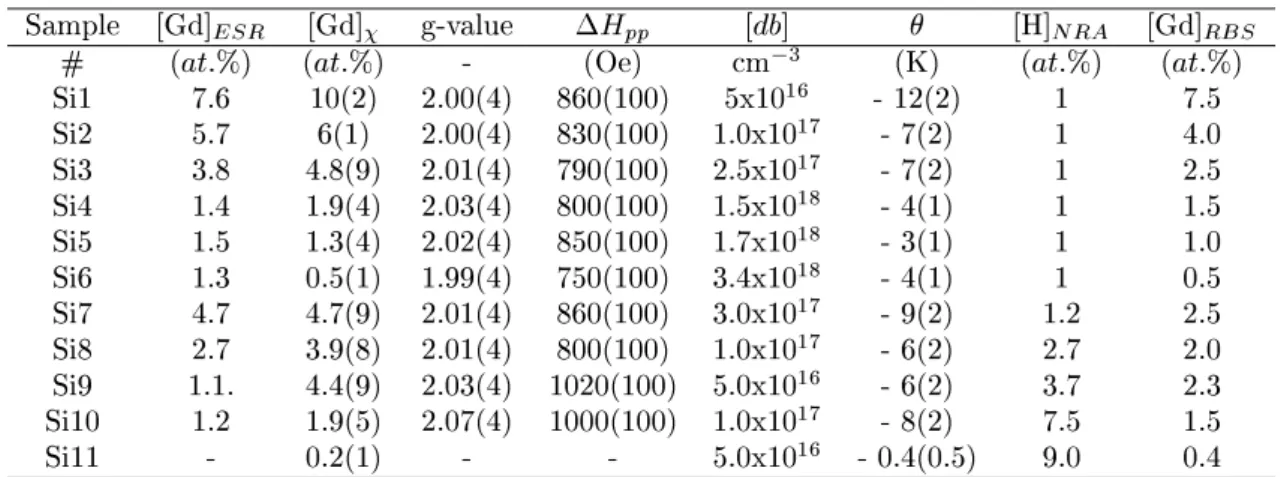Magneti Properties of Gadolinium-Doped
Amorphous Silion Films
M.S. Serheli, C. Rettori,
InstitutodeFsiaGlebWataghin,Uniamp,13.081-970 Campinas,SP,Brazil
and A.R.Zanatta
InstitutodeFsiadeS~aoCarlos-USP, 13560-250S~aoCarlos,SP,Brazil
Reeivedon23April,2001
Eletronspinresonane(ESR)andd-magnetizationexperimentshavebeenperformedinGd-doped
amorphous (a-)silion lms. The lms were deposited by the osputtering tehnique following
dierentonditions renderingsampleswithvaryingGdandhydrogenonentrations. Inaddition
to lms with dierent ontents of impurities and, in orderto probe the inuene of the atomi
strutureonthemagnetipropertiesoftheGdspeies,thelmswerealsosubmittedtolaser-indued
rystallizationproessing. BothESR andd-magnetizationresults showthat Gdis inorporated
asatrivalention (Gd 3+
) inthe Sihost. ESRdataindiateastrongdependenebetweenthe Gd
onentrationandthedensityofSidanglingbonds.Moreover,theGd 3+
loalenvironmentisnearly
insensitivetotheGdand Hontent,aswellas totheatomistrutureoftheSihost. Alongwith
gadolinium,otherrare-earthspeieshavebeeninvestigatedandthemainresultsaredisussed.
Muhof theurrentinterestinstudying rare-earth
(RE) dopedsilion-basedompounds arisesfrom their
potentialtoombine theuniqueoptial harateristis
ofRE 3+
ionswith theeletrial propertiesof
semion-dutor hosts. Moreover, despite the great advanes
ahieved in this area, still there are a lot of
interest-ingandunansweredquestions.[1℄Whilevariousgroups
around the world sueeded in doping several (either
rystalline or amorphous) Si-based matries with
dif-ferentRE 3+
ions,itisnotyetompletelylearwhatis
the loal hemial environmentaround theRE 3+
ions
and the involved energies.[2℄ Although it seems to be
more an aademi than a tehnologial problem, it is
important to stressthat these twoaspetsmay
deter-mine both,thedesignandthenalperformaneofthe
desiredopto-eletronidevies.
Based on these ideas this work presents a
system-atiandpreliminarystudyofthemagnetipropertiesof
dierentseriesofGd-dopedamorphous(a-)Silms
pre-paredbytheosputteringtehnique. Gdatomsandthe
osputtering tehnique have been respetively hosen
inviewoftheirmagnetiharateristisandversatility
inproduinglmswithquitedierentandontrollable
atomi ompositions. Toget further insight,auxiliary
spetrosopitehniques were employed to investigate
thelms. Besides,andwereappliable,allusionto the
study ofotherRE 3+
ionsin similarSihosts ismade.
Gd-dopeda-Sianda-Si:Hlmshavebeendeposited
by theosputteringtehniquein astandardradio
fre-queny (13:56 MHz) system. The lms, typially
1m thik, were deposited on high-purity quartz
substrates at 70 o
C in a Ar + H
2
atmosphere
a-ording to dierent target omposition [Gd-to-Si
rela-tivearea(A
Gd /A
Si
)℄andpartialpressuresofhydrogen
[P(H
2
)℄. After deposition, some of the Gd-doped
a-Si(H)wererystallizedwithaNd-YAGlaser(532:0nm
andpulsewidthof10ns).[3℄Thelmswereinvestigated
bymeansofoptial(absorptionandRamansattering)
tehniquesatroomtemperature. TheESRexperiments
werearriedoutinaBrukerX-bandspetrometer,
us-ingaTE
102
room-T avityand aheliumgas ux (4:2
K 300K) temperatureontroller. d-magnetization
measurements were performed in a Quantum Design
SQUIDMPMSmagnetometer(RSOmode). The
sam-plewaskeptat theenterof thesan rangeusing the
sampleautotrakingoption.
The Gd onentration of the samples reported in
this work were obtainedfrom: i) Rutherford
baksa-teringspetrosopy(RBS),ii)anestimationoftheESR
signalintensity as ompared with one ESR standard,
and iii) a Curie-Weiss tting of the low-temperature
d-magneti suseptibility, (T), data, after
substra-tion of the diamagnetism of a similar undoped thin
lm/quartz substrate sample. The hydrogen ontent
ofthelmsweredeterminedbyeitherNulearreation
analysis(NRA)oroptialabsorptionintheinfrared
re-gion. Some of the main harateristisof the studied
Gd-dopeda-Si(H)lmsarepresentedinTableI.
The temperature dependene of the [(T)℄ (1 T)
were measuredfor alla-Si(H) lms, and thedata was
tted to a Curie-Weiss law with dierent Gd 3+
(4f 7
,
Gd 3+
onentrationandparamagnetitemperature[℄
forallthestudied lmsaregivenin TableI.TheESR
spetra onsist of a broad and single resonane line
assoiated to a powder-like spetrum of Gd 3+
. The
intensity of this resonane depends on [Gd℄ and
in-reasesatlowtemperaturefollowingapproximatelythe
1=T behaviourappropriate forloalized magneti
mo-ments. Withintheexperimentalerror,theg-valueand
linewith H
pp
does not depend onthe Gd 3+
onen-tration and temperature for T & 30 K. On the other
hand,Gd-dopeda-Silmswith[Gd℄&4at:%andT .
30 K, presenta small line broadening, suggestingthe
existene of Gd-Gd magneti interations. However,
low eld 0:1 0:5 kG suseptibility measurements in
these high onentrated lms did not show any
spin-glassbehavior.[4℄TheGd 3+
onentrationwasalso
de-termined omparing the ESR intensity with a known
Gd
1:45 Ce
0:55 RuSr
2 Cu
2 O
10+Æ
sampleandastrong
KCl-pith standard. Themain ESRparametersand Gd 3+
onentrationaregiveninTableI.Thevaluesobtained
fromthe(T)measurementsandthedensityofSi
dan-glingbondsarealsoshownin TableI.
χ
Figure 1. (T) of the hydrogenated lms Si7, Si10 and
Si11,at1T,aftersubtrationofthepurea-Silm/quartz
substrate diamagnetism. Continuouslinesorrespond toa
Curie-Wiesslawandthettingparametersaregivenin
Ta-ble I. Inset: room temperature ESR spetra of the same
Gd-dopeda-Silmswithvarying[H℄.
The(T)ofthe(hydrogenated)Si7,Si10,andSi11
lms,measuredat1T,arerepresentedinFigure1. The
experimentaldatawasttedtoaCurie-Weisslawwith
4:7, 1:9,and 0:2at:%ofGd 3+
(4f 7
;S =7=2;7:94
B )
for samples Si7, Si10, and Si11, respetively. The
in-setofFig. 1showstheroomtemperatureESRspetra
of the same hydrogenated lms. ESR measurements
were also performed at low temperatures and onsist
of a broad and single resonane line that, within the
experimentalerror, doesnotdependon[H℄ noronthe
temperature. Similarlytothenon-hydrogenatedlms,
the intensity of this resonane signal inreases at low
temperatures and follows approximately the 1=T
be-arealsoshownin TableI.
Notiethat,despitetheuseofaonstantA
Gd /A
Si ,
the preseneof H
2
during deposition redues thenal
onentrationof Gdin thelms. Itis anexpeted
re-sult sine we have adopted a onstant total pressure
of 510 3
Torr for all deposition runs. As a
onse-quene, and takinginto aountthe sputteryield due
to H +
n
and Ar +
ions, [5℄ the onentration of Gd will
besmallerasmoreandmorehydrogenatomsareused
duringthedepositions.
Theeetof hydrogeninsertionin thea-SiGd
ma-trixwasalsoinvestigatedthroughoptialspetrosopy.
Asexpeted,[6℄andaordingtotheexperimentaldata,
theintrodution ofhydrogen in thea-SiGd matrix
in-duesabandgapwidening andaonomitant
passiva-tionofSidanglingbonds(seeTableI).
Atthispointitisimportanttonotiethat,while
hy-drogenatomspromotearealpassivationoftheSi
dan-glingbonds,theGd 3+
ionsatinadierentmannerin
reduingthe[db℄. ThedensityofSi danglingbonds,as
obtained from the ESRmeasurementsfor various
dif-ferent RE-doped (RE = Y, La, Gd, Er, and Lu) a-Si
lms,isstronglysuppressedonlybythemagnetiRE 3+
ions.[7℄ThisindiatesthatRE 3+
ionsizeeetsanbe
negletedasapossibledbdepletingmehanism,andthe
spin omponentof theRE 3+
(maximumfor Gd 3+
) is
probablythemainresponsibleforthe[db℄diminution.
χ
Figure2. d-magnetizationsuseptibility,at1T,oflmSi2
before(a-Si2)andafter(l -Si2)laser-rystallization
exper-iments. The Curie-Wiesslawis also represented for (T)
andthettingparametersaregiveninTableI.Inset: room
temperatureRamansatteringspetraofthesesamelms.
Afterlasertreatment,notietheappearaneofaRaman
sig-nalat520m 1
duetotheexisteneofSinano-rystals.
Some results of the laser-rystallization
experi-ments arepresentedin Figure 2where the(T)
spe-tra, measured at 1 T, of lm Si2 are shown before
and after rystallization. The inset displays the
or-responding room temperature Raman spetra for the
same lms. As an be seen from the inset, the
ompound.[8℄ After laser-rystallization, the lm
ex-hibitsawelldenedRamansignalat~520m 1
typial
ofSi nano-rystals.
Exept for a partially rystallized atomi
struture,[9℄ the experimental data was tted to a
Curie-Weisslawwith6at:%ofGd 3+
,andthemagneti
harateristis of the laser-rystallized lms resemble
verymuhthose ahieved in theamorphousase, i:e.,
beforethelaser-induedrystallizationproessing.
Based on the above experimental results the ESR
andd-magnetisuseptibilitydatademonstrate
unam-biguouslythatGdatomsareinorporatedinSias
triva-lent ionsGd 3+
. Moreover,the ESRresultsshowthat
the Gd 3+
powder-likespetraparametersare not
sen-sitive to the Gd onentration, atomi struture, and
H ontent. Both theg-valueand linewidth forall the
studied lms areabout thesame(Table I).This is an
intriguing result, beause it is known that the Gd 3+
ESR spetra is omposed of an anisotropine
stru-ture dueto rystaleld eets and, asaonsequene,
it should be aeted bydierentenvironmentsat the
Gd 3+
sites. These results suggest that the
neighbor-hoodoftheRE 3+
,in a-Si hosts,is notaeted bythe
dierentatomistruture of thestudied lms. A
pos-siblereasonforsuhabehaviorouldbetheformation
ofaverystableovalent-likeRESi
2
ompound.
Thin lms ofGd-dopeda-Si:H, with dierent[Gd℄
and[H℄,havebeenpreparedby theosputtering
teh-nique. Allied with some optial properties, the (T)
and ESRresults presented in this work allowed us to
onludethat: i) Gd atomsare inorporatedas
triva-lent ions (RE 3+
) in a-Si matries, ii) the RE 3+
ions
inorporated in our lms form an extremely stable
omplex,probablyRESi
2
and/orsomerelatedovalent
ompound, iii) in the a-SiRE:H lms the atual RE
onentration is muh smaller than the expeted one
(based on A
Gd /A
Si
) as a onsequene of the
deposi-tionmethod, iv) the [db℄ in the a-Si lms is strongly
depletedbythemagnetiRE 3+
speies. Thestrongest
eetisobtainedforGd 3+
,suggestingamehanism
as-soiatedtothespinomponentoftheRE 3+
viaastrong
exhange eld-likeouplingbetweentheRE 3+
anddb
spins.
TheauthorsareindebtedtoProfessorF.L.FreireJr.
(PUC-RJ)fortheion beamanalysesand to Professor
F.Iikawa(UNICAMP)fortheaesstotheRaman
fa-ilities. This work was supported by CAPES-Brazil,
CNPq-Brazil, FAPESP-Brazil, NSF-DMR-USA, and
NSF-INT-USA.
Table I - Gd onentrationas determined from ESR (room temperature)and (T) measurements. Theg-value,
H
pp
, Si danglingbonddensity[db℄, valuesand theatomionentrationofH andGd,asdeterminedfrom ion
beamanalyses(NRAand RBS),arealsodisplayedfortheseriesofGd-dopeda-Si:Hlms.
Sample [Gd℄
ESR [Gd℄
g-value H
pp
[db℄ [H℄
NRA [Gd℄
RBS
# (at:%) (at:%) - (Oe) m
3
(K) (at:%) (at:%)
Si1 7.6 10(2) 2.00(4) 860(100) 5x10 16
-12(2) 1 7.5
Si2 5.7 6(1) 2.00(4) 830(100) 1.0x10 17
-7(2) 1 4.0
Si3 3.8 4.8(9) 2.01(4) 790(100) 2.5x10 17
-7(2) 1 2.5
Si4 1.4 1.9(4) 2.03(4) 800(100) 1.5x10 18
-4(1) 1 1.5
Si5 1.5 1.3(4) 2.02(4) 850(100) 1.7x10 18
-3(1) 1 1.0
Si6 1.3 0.5(1) 1.99(4) 750(100) 3.4x10 18
-4(1) 1 0.5
Si7 4.7 4.7(9) 2.01(4) 860(100) 3.0x10 17
-9(2) 1.2 2.5
Si8 2.7 3.9(8) 2.01(4) 800(100) 1.0x10 17
-6(2) 2.7 2.0
Si9 1.1. 4.4(9) 2.03(4) 1020(100) 5.0x10 16
-6(2) 3.7 2.3
Si10 1.2 1.9(5) 2.07(4) 1000(100) 1.0x10 17
-8(2) 7.5 1.5
Si11 - 0.2(1) - - 5.0x10
16
-0.4(0.5) 9.0 0.4
Referenes
[1℄ Rare-EarthDopedSemiondutorsII,Eds.S.Coa,A.
Polman,andR.Shwartz(Mater.Res.So.,Pittsburgh,
1996),Vol.422.
[2℄ Forareviewonthesubjetsee,forinstane,A.Polman,
J.Appl.Phys.82,1(1997).
[3℄ See,forexample,M.Bell,L. Nunes,andA.R.Zanatta,
J.Appl.Phys.86,701(1999).
[4℄ F.Hellman,M.Q.Tran,A.E.Gebala,E.M.Wilox,and
[5℄ B.Chapman, inGlow Disharge Proesses, Sputtering
andPlasmaEthing(JohnWiley,NY,1980).
[6℄ R.A.Street,inHydrogenatedAmorphous Silion
(Cam-bridgeUniversityPress, Cambridge1991).
[7℄ M.S.Serheli, A.R. Zanatta, andC.Rettori, Magneti
Properties of Rare Earth Doped Amorphous Silion
Films(tobepublish).
[8℄ J.S.Lannin,inSemiondutorsandSemimetals,Ed.J.I.
Pankove(Aademi,NY,1984),Vol.21B,pp.159-196.
[9℄ Z. Iqbal and S.Veprek,J. Phys.C: Solid State Phys.

